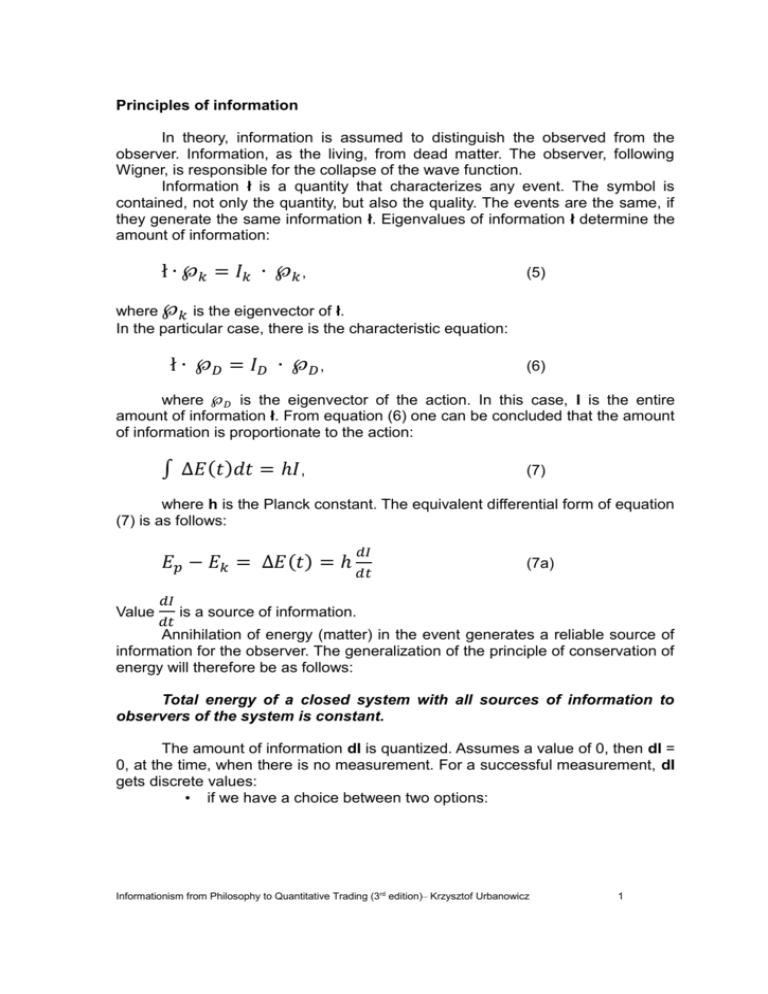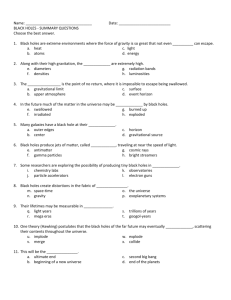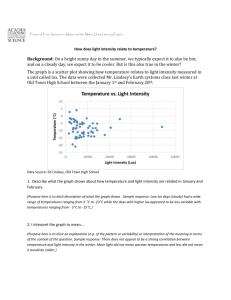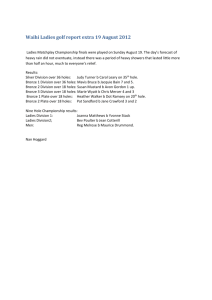Generalization of de` Broglie Thesis Abstract
advertisement

Principles of information In theory, information is assumed to distinguish the observed from the observer. Information, as the living, from dead matter. The observer, following Wigner, is responsible for the collapse of the wave function. Information ł is a quantity that characterizes any event. The symbol is contained, not only the quantity, but also the quality. The events are the same, if they generate the same information ł. Eigenvalues of information ł determine the amount of information: ł ∙ ℘𝑘 = 𝐼𝑘 ∙ ℘𝑘 , (5) where ℘𝑘 is the eigenvector of ł. In the particular case, there is the characteristic equation: ł ∙ ℘𝐷 = 𝐼𝐷 ∙ ℘𝐷 , (6) where ℘𝐷 is the eigenvector of the action. In this case, I is the entire amount of information ł. From equation (6) one can be concluded that the amount of information is proportionate to the action: ∫ Δ𝐸 (𝑡)𝑑𝑡 = ℎ𝐼 , (7) where h is the Planck constant. The equivalent differential form of equation (7) is as follows: 𝐸𝑝 − 𝐸𝑘 = Δ𝐸 (𝑡) = ℎ Value 𝑑𝐼 𝑑𝑡 (7a) 𝑑𝐼 is a source of information. 𝑑𝑡 Annihilation of energy (matter) in the event generates a reliable source of information for the observer. The generalization of the principle of conservation of energy will therefore be as follows: Total energy of a closed system with all sources of information to observers of the system is constant. The amount of information dI is quantized. Assumes a value of 0, then dI = 0, at the time, when there is no measurement. For a successful measurement, dI gets discrete values: • if we have a choice between two options: Informationism from Philosophy to Quantitative Trading (3rd edition)– Krzysztof Urbanowicz 1 dI = • • 1 log2(2) = 1, 2 log2(2) = 2, 3 log2(2) = 3... if we have a choice among three possibilities: dI = 1 log2(3) = 1,58496, 2 log2(3) = 3,1699... if we have a choice among four possibilities: dI = 1 log2(4) = 2, 2 log2(4) = 4... Etc… Following this, we can determine all possible values of actions (amount of information). Information theory allows the size of the action that are not integer numbers, which makes it different from the assumptions of Quantum Mechanics. Max Planck at the beginning of last century assumed the existence of quant of action, which is consistent with the experience. With this assumption it follows that the smallest quant of action is h, the Planck's constant, which is consistent with the Theory of Information. Information Theory goes a step further and provides an additional, larger quant of action. At this point, this effect could be used to experimentally confirm the thesis of Information Theory. Equation (7) has a dimension of action, so in the analogy to classical physics, we can define the version information of minimal action in the form of: • In real systems, the event takes place in a manner that generates the smallest possible amount of information. Given that the minimal amount of information is one bit, we can write the inequality: 𝑑𝐼 ≥ 1 → Δ𝐸 ∙ Δ𝑡 ≥ 1 (8) Inequality (8) is the Heisenberg uncertainty principle and is taken from definition of information. You can easily determine the equivalent of the Heisenberg uncertainty principle in momentum space, ie 𝑑𝐼 ≥ 1 → Δ𝑝 ∙ Δ𝑟 ≥ 1, (9) where p is the momentum, and r position in space. We are getting a new equation for the transformation of information, namely: Δ𝐼 ∙ ℎ = Δ𝑝 ∙ Δ𝑟 (10) From equation (10) by differentiation after dt, it can be concluded, that the work done on the system minus the change in kinetic energy of the system is also a source of information. To generate, information can be simply created by the ordinary work on the matter. Of course, not all the matter then disappear. Simply, because we are not able to observe as much information (the inverse of Planck's constant, which is about 10e34 bits). Informationism from Philosophy to Quantitative Trading (3rd edition)– Krzysztof Urbanowicz 2 Using principle of minimal creation of information, we can make a useful way to calculate such incident. The measure of information may be the Shannon information entropy, S, which describe the level of an uncertainty of the event: 𝑆 = − ∫ 𝑃(𝑥 ) ∙ 𝑙𝑛(𝑃(𝑥 )), (11) where P(x) is the probability of an event and ∫ 𝑃 (𝑥 ) = 1. For events with the smallest amount of information, entropy will have the greatest value, or the largest possible uncertainty. Considering the experience of Young's two slits, we can calculate how the quant of energy (light beam) will pass through the gap, generating the least amount of information. Calculate the maximum entropy. It turns out that the 1 maximum entropy S is taken for 𝑝1 = 𝑝2 = . This means that the probability of 2 passing through one slit and the other are equal to 50%. Informationism from Philosophy to Quantitative Trading (3rd edition)– Krzysztof Urbanowicz 3 The generalization of the de'Broglie waves - information carrier This is a generalization of de ‘Broglie thesis, which gives the basis for a claim of corpuscular-wave duality. De‘Broglie wrote his dissertation thesis, which had only one site. He defended the work and, of course, it became the basis of all modern physics. The thesis of de'Broglie was as follows. Each body moving with a non-zero velocity, generates the de'Broglie waves with length λ: 𝜆= ℎ 𝑝 , (12) where p is the momentum of the body. p is the momentum in classical mechanics, that is mass multiply by velocity (p = mv). However, we do not use this equation, because in relativistic physics, mass is different from the rest mass and the speed should always refer to the speed of light c, which is the maximum value. The question arises, what if the mass is at rest? Does it still generates waves, that can be a carrier of information? The answer is simple. Of course it generates. Annihilation of matter causes creation of generalized the de'Broglie waves, which are carriers for information, originating from the annihilation (disappearance) of the particle matter. Note, information is always regardless of velocity of body, so it must have a carrier and spreads with a speed of light. Max Planck equation is as follows: 𝑬= 𝒉∙𝒄 (13) 𝝀 It is easy to draw this equation from the preceding equations. From equation (13) and (1), one can easily write the final equation for the length of already generalized de'Broglie wave produced during annihilation of mass Δ𝑚: 𝜆= ℎ Δ𝑚∙𝑐 , (14) where h = 6.62606957(29)×10-34 J·s, and c = 299792458 m/s. In practice, the disappearance of 1 kg weight causes the production of wave with wavelengths: 𝜆= 6.626×10−34 299792458 𝑚 In conclusion, the generalized de'Broglie waves appear at the time of annihilation of matter and are a carrier for information generated at this event. Information is written in Fourier space of these waves. Informationism from Philosophy to Quantitative Trading (3rd edition)– Krzysztof Urbanowicz 4 Experiment to proof Theory of Information General description of idea of the experiment This experiment should show existence of non-integer values of actions, more precisely we focus on action of value log2(3) = 1.585 h (see page 17). In order to proof this we should give, for some event, to choose one from three possibilities. We will focus on laser light, which pass through three holes and then compare this to the same laser passing through only 2 holes. When laser light is passing through 2 holes, nothing special should come up, because there is generated action of a value log 2(2) = 1 h. In opposite should happen to laser light passing via 3 holes, because some of light will go via 3 holes at ones as a wave and collapse when detected. How much of laser light would go through 3 holes at ones? One can calculate via path integrals or by simply combinatory: Probability that light as a wave is going thought only one from 3 holes is x, so going via 3 separately is 3x. • Probability that light will go via 2 holes at once is x2. Such combinations are 3, so probability as a whole is 3 x2. • Probability that light will go via 3 holes at once is x3. Such combinations are only 1, so whole probability is x3. Light intensity is linear proportional to probability squared, so let's calculate how much light intensity (LI3) is going to induce non-integer action? • 1 𝐿𝐼3 = 3𝑥 3 𝑍 𝑍 = 3𝑥 + 2 ∙ 𝑥 2 + 3 ∙ 𝑥 3 (14a) If we put Z = 100%, then it gives x = 0.2229 and LI3 = 3.3% The non-integer action should change the about 3.3% of laser light power with wavelength (see Eq. 7a and 13) : 𝜆3 = 𝜆 , 1.585 (14b) where 𝜆3 is the wavelength, which goes through 3 holes at once. Of course the description above is simplified and it is not going to change the wavelength of part of light intensity to such value. It will rather distribute wavelength in Gaussian process. In order to capture the change, we will measure the light intensity depending on distance to light source. In this sense we measure the mean scattering of the light in the air. If the Theory of Information is true, we should see larger scattering of laser light, which goes through 3 holes than 2. This is because, in the mean, wavelength of laser light will decrease by 1.585 * 0.033 = 5.2% when goes via 3 holes. The Rayleigh Scattering in the air, in simplify equation, is given by following: Informationism from Philosophy to Quantitative Trading (3rd edition)– Krzysztof Urbanowicz 5 𝐼~𝐼0 1 , 𝜆4 𝑅 2 (14c) where R is the distance to light source. In our experiment slope of light intensity against distance should be (1.052)4=1.225 larger for 3 holes setup than for 2 holes once. One have to admit that standard theories does not differ the situations between 3 and 2 holes, so slopes should be the same in both situations. Standard theory of laser light scattering In standard theory one should resolve Maxwell equations. We have made this using commercial software LightTrans VirtualLab (http://www.lighttrans.com). We have simulated 2 and 3 pinholes as it will be described in section below. We have measured light intensity in LUX on distances 2, 4, 6 meters from diaphagram. The light source was laser with simulated Gaussian wave and length 532 nm. In the pictures below is shown the light interference at 2, 4, 6 meters from left for 2 pinholes and below for 3 pinholes. On bottom of pictures simulated light intensity in Lux. One can calculate that there is no difference between scattering in air of 2 and 3 pinholes in the case of simulation. Informationism from Philosophy to Quantitative Trading (3rd edition)– Krzysztof Urbanowicz 6 The results of light intensity given on bottoms of pictures are summarized below: 200 mm 400 mm 600 mm 2 pinholes 44.709 lux 11.177 lux 4.9676 lux 3 pinholes 57.909 lux 14.477 lux 6.4343 lux One can easily calculate, that for 2 pinholes the light intensity for 200 mm divided by one for 600 mm is the same as for 3 pinholes (around 9=44.709/4.9676=57.909/6.4343). Setup the experiment In the setup we use diaphragm with 3 little holes with radius 0.35 mm, which formed equilateral triangle with side 0.5 mm and ones with 2 little holes with the same parameters. Look at pictures below. Informationism from Philosophy to Quantitative Trading (3rd edition)– Krzysztof Urbanowicz 7 To measure an intensity of laser light, we use “Light Meter HS1010” produced by Sunche. This apparatus measure the intensity in LUX with precision ±1 LUX. Results In our experiment we measure laser light intensity which goes through diaphragm with 2 or 3 holes on different distance to diaphragm. The raw results are as follows: Laser with wavelength 405 nm: Laser with wavelength 532 nm: Laser with wavelength 650 nm: Informationism from Philosophy to Quantitative Trading (3rd edition)– Krzysztof Urbanowicz 8 We take the mean from two samples of each raw and each number of holes and calculate the linear regression. Plots below shows means light intensity in LUX for different lasers. In order to see better the slopes plots are shifted so that the endings are settled to common values. The main results are calculated linear regression: We have to comment with a few words. The power meter apparatus has the pick sensitivity on green light, and almost no fragility to red and blue one. Thus is why, the agreement with theory is best (but not perfect) for green laser. In order to have agreement with theory one should have larger slope for 3 holes setup than for 2 two holes about 1.225 times larger, so: -0.666 * 1.225 = -0.82. As we see we have -0.9544±0.14, so the result is within the error. Informationism from Philosophy to Quantitative Trading (3rd edition)– Krzysztof Urbanowicz 9 Conclusions In the experiment, we show, that slopes are quite different for 2 and 3 holes. In the case of green light we have also quite good numerical results in experiment and what theory is providing. Standard theories does not recognize these two situations as different, what was the case in simulation, so one can conclude that we proof existence of non-integer action and in this moment we proof Theory of Information. Informationism from Philosophy to Quantitative Trading (3rd edition)– Krzysztof Urbanowicz 10





